Weigh house
A weigh house or weighing house is a public building at or within which goods are weighed. Most of these buildings were built before 1800, prior to the establishment of international standards for weights. As public control of the weight of goods was very important, they were run by local authorities who would also use them for the levying of taxes on goods transported through or sold within the city. Therefore, weigh houses would often be near a market square or town centre.
Between 1550 and about 1690 people accused of witchcraft were at times brought to a weigh house in order to be subjected to a "witch test" to "prove" their innocence for payment (as nobody was deemed to be a witch after this test[1]). If a person was found to be lighter than a set weight, he or she was deemed guilty. This is similar to the use of a ducking stool.
Weigh houses were especially common in the Netherlands, Germany, where they are called waag and waage respectively (both meaning "scale") and Poland (waga miejska, "town/city scales", as in Kraków and Poznań). Outside the Netherlands and Germany the public weighing usually didn't take place in a special building, but in a town hall, guild hall, courthouse, or the like.
Netherlands
Alkmaar
One of the very few remaining weigh houses still in use is the one in Alkmaar, Netherlands, where the Cheese Market still includes the weighing of the cheeses as a demonstration for tourists.
Amsterdam
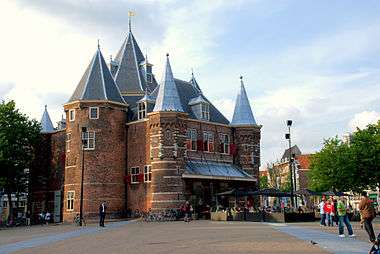
The Amsterdam Waag is a remnant of the former city walls in Amsterdam. Constructed in 1488, it was originally one of the city gates, the Sint Anthoniespoort. When the city expanded, the Nieuwmarkt (new market) was created around it and the weighing scales for the market were placed in the former gate. Today the building houses the Waag Society, an ICT research foundation working in the social and cultural domain, and there is a café/restaurant on the ground floor.
The building carries the oldest plaque in Amsterdam, which reads On 28 April 1488 the first stone of this gate was laid.
The city walls that the Sint Anthoniespoort was part of were built in the years 1481-1494. These walls have now completely disappeared and the only remnants are this gate, the lower part of another gate, the Regulierspoort (now the Munttoren) and one defence tower, the Schreierstoren. When in the late 16th century the city expanded the wall was torn down and the gate lost its function. The defensive canal and palissade around the gate was turned into a market square. In the process the ground level was raised, so the building is no longer quite as high as it used to be. For the new weighing function the original front and rear gate were connected with a roof.
The upper floors housed four guilds for some time, namely those of the smiths, painters, masons and surgeons. Each guild had its own entrance tower. In 1632 Rembrandt van Rijn was commissioned to paint the surgeons at work, and the resulting The Anatomy Lesson of Dr. Nicolaes Tulp made his reputation. In 1691 a theatrum anatomicum was added, which became famous for admitting (paying) members of the public to witness human dissections.
After the guilds were dissolved around 1795 the building served numerous purposes, later housing a fire brigade and two museums (including the Jewish Historical Museum) before it was handed over to a foundation in 1990. This had plans to partly destroy the building and build an addition designed by Philippe Starck, but the foundation went bankrupt before any plans were carried out. The neighbourhood and monument lovers convinced the Amsterdam city council that the building deserved a better fate. It was decided to restore it in keeping with its medieval background. Waag Society became the principal tenant in 1996.
Other cities
A number of other Dutch towns also have a weigh house, including Delft, Deventer (with museum), Edam, Enkhuizen, Gouda, Haarlem, Hoorn, Langweer, Leeuwarden, Leiden, Nijmegen, Oudewater (Heksenwaag = witches' weighing house), Vlaardingen and Zaltbommel. Pieter Post, a Golden Age architect, had his weigh house design chosen for two cities; Gouda, and Leiden:
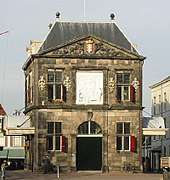
Kaaswaag
Gouda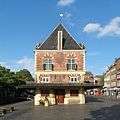
Waag
Leeuwarden
Waag
Leiden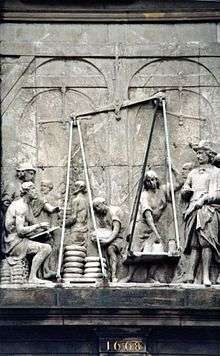 Relief showing the weighing process (Gouda)
Relief showing the weighing process (Gouda) Facade of the weigh house in Zaltbommel (built 1796-1798)
Facade of the weigh house in Zaltbommel (built 1796-1798)
Germany
Cities in Germany, where such a building (in German called Stadtwaage) still exists, are (among others): Braunschweig, Bremen (Bremen Weigh House), Dorsten, Emmerich am Rhein, Kempten, Leipzig, Michelstadt, Osnabrück and Stralsund.
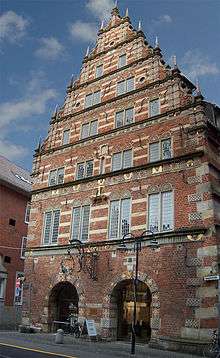
 Goldene Waage in Frankfurt, built in 1619, destroyed 1944, to be rebuilt 2014-16 (Dom-Römer Project)
Goldene Waage in Frankfurt, built in 1619, destroyed 1944, to be rebuilt 2014-16 (Dom-Römer Project)
Ireland
Weigh houses were formerly found in many market towns of Ireland; a notable surviving example is in Gort, County Galway, built in the mid- to late 18th century.[2]
Poland
Cities in Poland such as Kraków, Poznań, Bochnia and Nysa had or have historical weigh houses.
Kraków
Kraków's both weigh houses stood in its Main Market Square, between the City Hall and the Church of St Adalbert. The Great Weigh House was also known as "Leaden" for the weighing of metals, and the Lesser as "Waxen" as its scales were also used for weighing wax. Despite later transformations, and adaptations, they were both demolished in the 19th century.
See also
- Weigh station, a checkpoint along a highway to inspect vehicular weights, usually equipped with a truck scale (weigh bridge)
- Södra Bankohuset, a former weigh house in Stockholm, Sweden
References
- "Museum De Heksenwaag". www.heksenwaag.nl. Retrieved 2016-04-02.
- http://www.antaisce.org/properties/crane-gort-weigh-house
External links
| Wikimedia Commons has media related to Weigh houses. |
